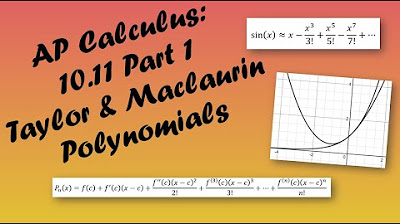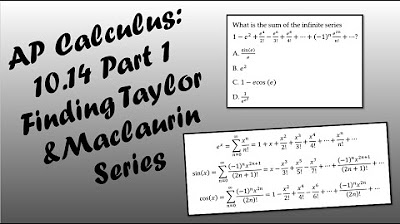Taylor & Maclaurin polynomials intro (part 1) | Series | AP Calculus BC | Khan Academy
TLDRThe video script discusses the process of approximating an arbitrary function using a polynomial, specifically focusing on the Maclaurin series. It explains how to construct a polynomial by adding terms that ensure the polynomial matches the function's value, first derivative, second derivative, and so on, at x=0. The script illustrates the concept with a step-by-step approach, showing how each additional term improves the approximation. The result is a series that, with an infinite number of terms, can closely resemble the original function, especially near x=0. The Maclaurin series is presented as a powerful tool for function approximation, with potential for further exploration in future videos.
Takeaways
- 📈 The script discusses the process of approximating an arbitrary function using polynomials of increasing degrees.
- 🔢 The approximation begins by evaluating the function at 0 and its derivatives at that point to establish initial conditions for the polynomial.
- 🏹 A polynomial of degree 0, a constant, is the simplest approximation but offers limited accuracy.
- 🌟 Adding more terms to the polynomial allows it to match the first, second, and further derivatives of the original function at x=0.
- 📌 The derivative of the polynomial at x=0 must match the corresponding derivative of the original function to ensure a good fit.
- 🔍 The process of adding terms is iterative, with each term designed to match the next higher derivative of the function at x=0.
- 📊 The Maclaurin series is introduced as the general form of the polynomial approximation centered at x=0.
- 🧩 Each term in the Maclaurin series is the nth derivative of the function at x=0 times x to the power of n divided by n factorial.
- 🌐 As more terms are added to the Maclaurin series, the polynomial increasingly approximates the original function, especially near x=0.
- 🦅 The Maclaurin series is a special case of the Taylor series, which can be centered at any point, not just x=0.
- 🎥 The video script suggests that further examples and a graphical demonstration will be provided in subsequent content for better understanding.
Q & A
What is the main goal of the script?
-The main goal of the script is to demonstrate the process of approximating an arbitrary function using polynomials of increasing degree, specifically focusing on matching function values and derivatives at a given point, in this case, 0.
What is the first assumption made about the arbitrary function?
-The first assumption made is that we can evaluate the function at 0 and know its value, denoted as f(0).
How does the script propose to improve the approximation of the function using polynomials?
-The script proposes to improve the approximation by adding terms to the polynomial, with each term designed to match the function's derivatives at the point x=0, up to increasing orders.
What is the significance of the term f'(0)x in the second polynomial?
-The term f'(0)x is added to the second polynomial to ensure that the first derivative of the polynomial, p'(x), matches the first derivative of the function, f'(x), at x=0.
What is the role of the 1/2 factor in the third term of the polynomial?
-The 1/2 factor is included to adjust the coefficient of the x^2 term so that when the second derivative of the polynomial, p''(x), is evaluated at x=0, it matches the second derivative of the function, f''(x), at that point.
How does the general form of the n-th term in the polynomial approximation relate to the function's derivatives?
-The general form of the n-th term is the n-th derivative of the function evaluated at 0, multiplied by x raised to the power of n, and divided by n! (n factorial). This ensures that the n-th derivative of the polynomial will match the n-th derivative of the function at x=0.
What is the name of the series that results from this polynomial approximation process?
-The series that results from this process is called the Maclaurin series.
How does the Maclaurin series relate to the Taylor series?
-The Maclaurin series is a special case of the Taylor series where the center point for the series expansion is 0.
What happens as you add more terms to the polynomial approximation?
-As more terms are added to the polynomial approximation, the polynomial increasingly fits the function's values and derivatives at x=0, leading to a better overall approximation, especially near x=0.
In theory, what would happen if an infinite number of terms were added to the polynomial?
-In theory, if an infinite number of terms were added to the polynomial, all of the derivatives of the polynomial and the function would match at x=0, and the functions would be nearly identical, providing an exact representation of the function near x=0.
Outlines
📚 Introduction to Polynomial Approximation
The paragraph discusses the process of approximating an arbitrary function using polynomials. It begins by explaining the assumption that the function can be evaluated at 0 and its derivatives can be calculated at the same point. The goal is to create a polynomial that matches the function's value, first derivative, and second derivative at 0. The explanation includes the construction of a simple polynomial with one term (a constant) and its limitations, followed by the introduction of additional terms to match the function's derivatives at 0. The paragraph also touches on the concept of a tangent line as an approximation and sets the stage for further refinements in the approximation process.
📈 Enhancing the Approximation with Higher Derivatives
This paragraph delves deeper into the method of improving the polynomial approximation by ensuring that not only the function's value and first derivative match at 0, but also the second derivative. It introduces a new polynomial term that includes half the second derivative of the function evaluated at 0, explaining the rationale behind the 1/2 factor. The paragraph then discusses the iterative process of adding terms to the polynomial to match the function's higher derivatives at 0, leading to a better approximation. The concept of the Maclaurin series is introduced as a general formula for this approximation process, with the potential to achieve a very close approximation to the function with an infinite number of terms.
🌐 Understanding the Maclaurin Series and Taylor Series
The final paragraph summarizes the process of polynomial approximation using derivatives, leading to the Maclaurin series, which is a specific case of the Taylor series centered at 0. It explains how each term in the series is derived from the function's derivatives at 0, multiplied by increasingly complex powers of x and divided by the corresponding factorial. The paragraph emphasizes the pattern observed in the series and how it can be extended to include higher derivatives. It also mentions the potential visual representation of the approximation, becoming increasingly accurate near x=0, and suggests that with an infinite number of terms, the approximation should theoretically match the function perfectly. The paragraph concludes by noting that the Maclaurin series is a special case of the Taylor series, which can be centered at any point, but the focus remains on the Maclaurin series for the moment.
Mindmap
Keywords
💡Arbitrary Function
💡Polynomial Approximation
💡Derivative
💡Maclaurin Series
💡Factorial
💡Degree of Polynomial
💡Tangent Line
💡Function Value at 0
💡Slope
💡Infinite Series
Highlights
The process of approximating an arbitrary function using a polynomial is discussed.
The assumption is made that the function can be evaluated at 0 and its derivatives can be found.
A polynomial of degree 0, a constant term, is used as the initial approximation.
The constant term is set equal to the function's value at 0 to start the approximation process.
Adding more terms to the polynomial allows for better approximation of the function.
The first derivative of the polynomial is matched with the first derivative of the function at 0.
The second derivative of the polynomial is made to match the second derivative of the function at 0 by adding a specific term.
The 1/2 coefficient in the second term is derived from the power rule and the need to cancel out the extra 2 from the power rule expansion.
The pattern of adding terms to the polynomial corresponds to the n-th derivative of the function at 0 times x to the n over n factorial.
The general series formed by this process is known as the Maclaurin series.
The Maclaurin series is a special case of the Taylor series centered at 0.
As more terms are added to the series, the polynomial approximation becomes increasingly accurate, especially near x=0.
In theory, with an infinite number of terms, the polynomial approximation should perfectly match the function and all its derivatives.
The process illustrated is a practical application of calculus and series expansion in function approximation.
The discussion includes visual representation of how the approximation improves with each added term.
The video aims to provide a deeper understanding of the relationship between polynomials and function approximation.
Transcripts
Browse More Related Video

Visualizing Taylor series approximations | Series | AP Calculus BC | Khan Academy

Polynomial approximation of functions (part 1)

AP Calculus BC Lesson 10.11 Part 1

Approximating functions with polynomials (part 3)

AP Calculus BC Lesson 10.14 Part 1

Maclaurin series of cos(x) | Series | AP Calculus BC | Khan Academy
5.0 / 5 (0 votes)
Thanks for rating: